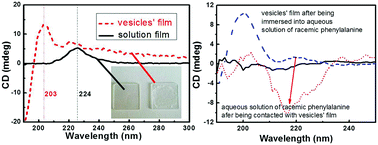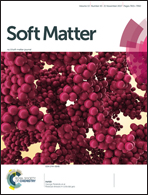Supramolecular chirality of amphiphilic block copolymer films made through two steps: self-assembling first, and then solution coating†
Abstract
Supramolecular chirality is achieved in amphiphilic block copolymer films made through two-step fabrication: self-assembling first and then solution coating. The amphiphilic block copolymer is composed of poly(N-isopropyl acrylamide) (pNIPAM) as hydrophilic segments and poly(methyl methacrylate) with chiral side groups as hydrophobic segments. The films fabricated by two steps show sensible circular dichroism (CD) signals around a wavelength of 200 nm. However, CD signals cannot be detected from films made by directly coating the solution of copolymers on the quartz surface. The CD signal at about 200 nm is from supramolecular arrangement of benzene units connected to the chiral group in the hydrophobic segment. This result is thought to be originated from the aggregation of the copolymer during the first step of the film forming process, and the corresponding investigation into factors affecting this process has been performed in this work. It is also found that the films fabricated by two steps can adsorb chiral small molecules enantioselectively, while the films obtained by coating the solution of copolymers directly have no such enatioselective adsorption ability.



 Please wait while we load your content...
Please wait while we load your content...